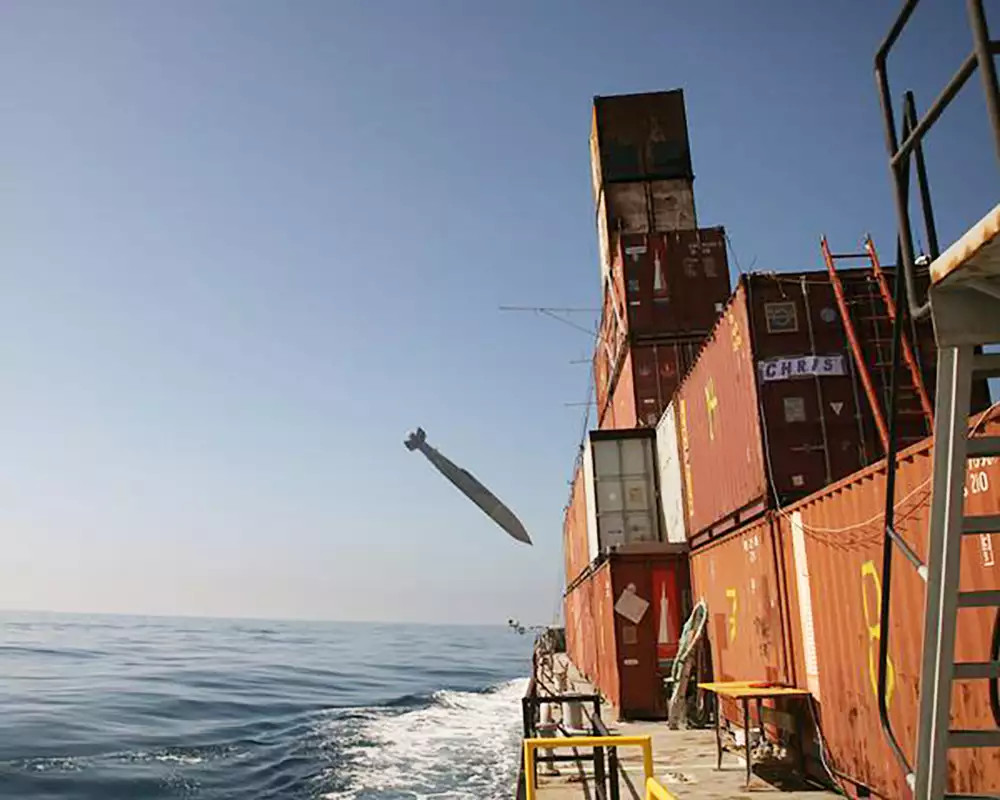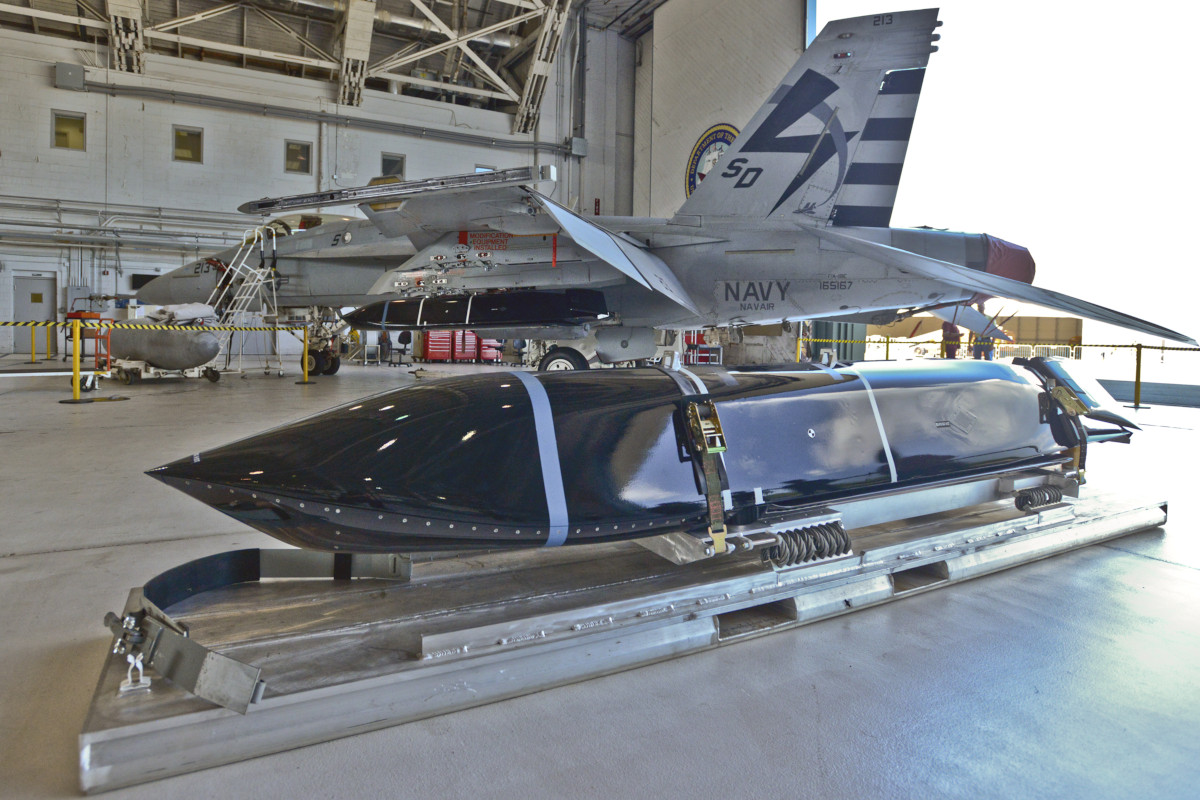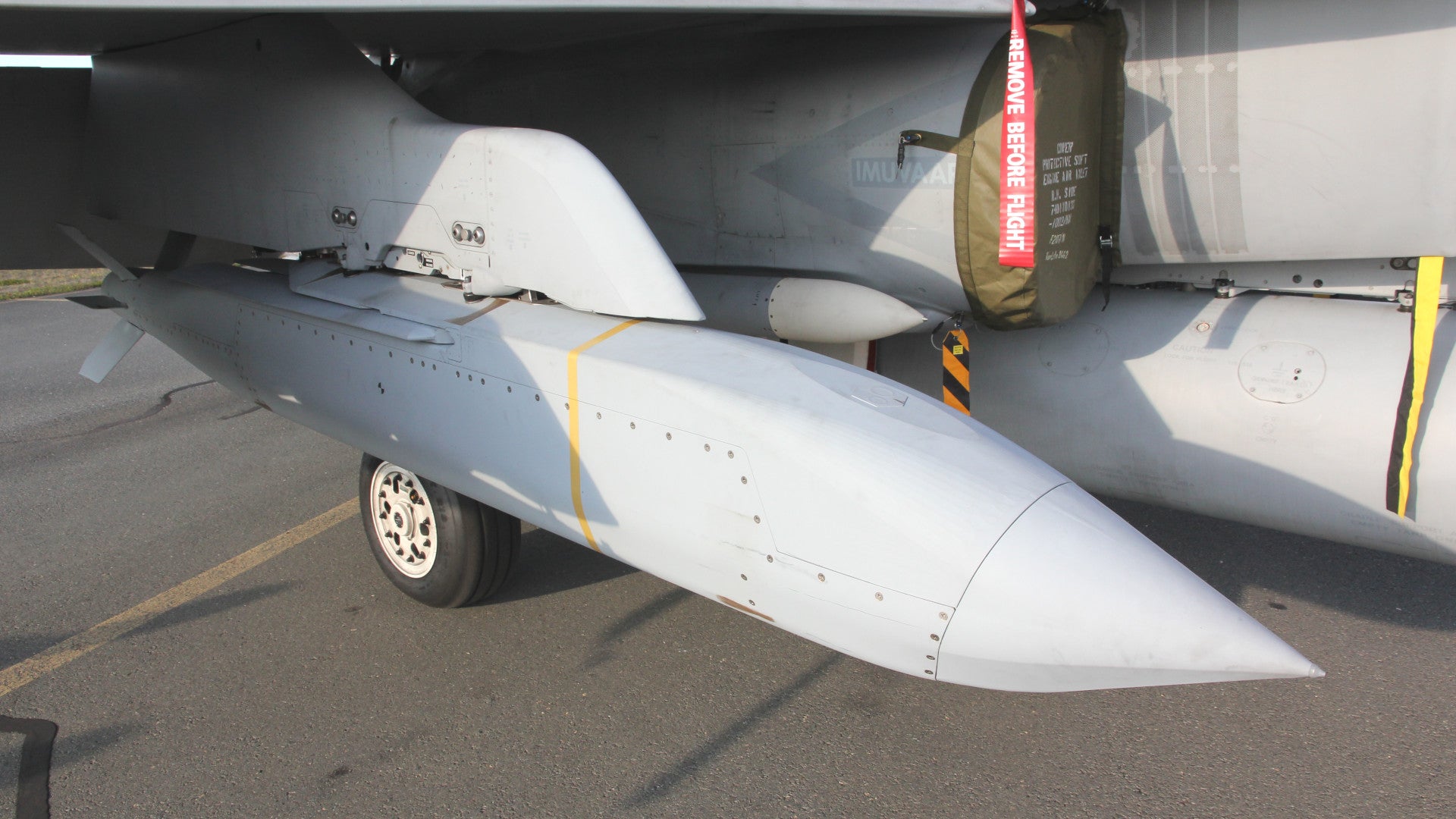The U.S. Navy says it will begin deploying a cruise missile derivative of the stealthy AGM-154 Joint Stand-Off Weapon glide bomb, or JSOW, no later than the end of 2023, as an option for its F/A-18E/F Super Hornets and F-35C Joint Strike Fighters. The weapons will give these jets a significant additional extended-range strike capability, which is important given the increasingly advanced nature of integrated air defenses among potential opponents, especially Russia and China.
On Feb. 7, 2019, Naval Air Systems Command (NAVAIR) announced its intention to issue a sole-source contract to Raytheon for work related to the new weapon, known as the JSOW-Extended Range, or JSOW-ER, on the U.S. government’s main contracting website, FedBizOpps. The Massachusetts-headquartered defense contractor developed the unpowered JSOW and you can read about it and the cruise missile derivative in depth in a previous feature from The War Zone. The notice also said that the JSOW-ER would be compatible with the U.S. Air Force’s F-35A Joint Strike Fighter, but it is not clear if that service actually intends to purchase the missiles.
“The Requirements for the JSOW-ER includes: extending the range of the existing JSOW [AGM-154]C-1 variant while maintaining targeting and performance capabilities, carriage on F-18 and internal carriage on F-35A/C while minimizing any changes to existing aircraft integration and limitations, hardware and software modifications to optimize midcourse and endgame performance for the powered variant of the JSOW, and deployment to the fleet no later than FY23,” the announcement explains.
The Navy has been actively working with Raytheon on the development of the JSOW-ER since June 2017. In April 2018, the service announced it was moving the program to a more advanced phase.

That same month, Raytheon declared that the unpowered AGM-154C-1, or JSOW-C, was fully compatible with the F-35C’s internal weapons bays. “This is absolutely a critical opportunity for the Navy because now this is their top-line, medium-range precision strike weapon that is capable now of being integrated internally on JSF,” Mark Borup, a member of Raytheon’s Medium-Range Strike and Attack Air Warfare Systems Division, said in an interview with Military.com at the time.
But the JSOW-ER concept actually dates back more than a decade. Raytheon had pitched the idea of a powered version with the Williams International WJ24-8 turbojet to the United Kingdom as part of the Conventionally Armed Standoff Missile (CASOM) program. This weapon lost out to European consortium MBDA’s Storm Shadow cruise missile.
In 2009, Raytheon flight tested a second iteration of the JSOW-ER using the Hamilton Sundstrand TJ-50 turbojet. The company also uses this engine to power its ADM-160 Miniature Air-Launched Decoy (MALD) system, which you can read about in more detail here. The design can also reportedly hit targets out to distances of nearly 265 miles, nearly four times the maximum range of the unpowered JSOW-C when released from a high altitude.

That added range is important given that potential opponents are only fielding surface-to-air missiles, as well as associated radars and other sensors, with ever-increasing range and precision. In turn, adding extra stand-off range to air-launched weapons will only become more vital to reduce the vulnerability to launching aircraft as time goes on.
Combined with the Navy’s stealth F-35C, in particular, the JSOW-ER will also give the Navy an additional means of targeting those defenses directly. The Joint Strike Fighters could then cut a path open for non-stealth platforms to follow through for subsequent strikes. The stealthy features of the JSOW-ER itself only help reduce its own vulnerability to enemy defenses. This combat doctrine would only be more potent with the help of electronic warfare support from EA-18G Growlers.
It is not clear if the latest JSOW-ER design still uses Hamilton Sundstrand TJ-50, as well as the flush-mounted intake that helps keep the weapon stealthy, from the 2009 design. It would make good sense that Raytheon would have continued to refine this version, though, which reportedly has the same basic dimensions as the unpowered AGM-154C-1. This would make it relatively easy to integrate into the F-35C’s internal weapons bays.
The JSOW-ER will otherwise retain many of the features of the existing JSOW-C, including its guidance package, according to NAVAIR’s notice. The latest Block III AGM-154C-1s added an imaging infrared seeker to the weapons existing GPS-assisted inertial navigation system (INS) targeting system. This additional feature allows it to spot and home in on targets in the terminal stage of flight and, as a result, engage moving vehicles, like ships.

NAVAIR also says it is looking for additional “hardware and software modifications to optimize midcourse and endgame performance,” which could include things such as a two-way data link that would allow the launching aircraft to send course corrections and other targeting updates to the missile in flight. A networked capability would also allow the weapon to work within the Navy’s Cooperative Engagement Capability (CEC) construct, meaning that other platforms in the air or at sea could help direct the weapon more accurately to its target, as well.

Another potential addition might be improvements to the missile so that it could make course corrections and avoid potential threats and hazards autonomously or semi-autonomously. This would be especially valuable for dodging pop-up air defenses.
One of the biggest benefits of the unpowered JSOW’s design was, and still is, its spacious modular payload bay that can accept any warhead based around the standard 500-pound-class low-drag bomb design. The JSOW-ER’s need to accommodate a jet engine and fuel will have an impact on the maximum warhead size, but it’s not clear whether it might still be able to readily accept new payloads that fit within those constraints.

The JSOW-ER offers all of this capability in a package this is likely to be a cost-effective alternative to larger air-launched cruise missiles, such as Lockheed Martin’s AGM-158A Joint Air-to-Surface Standoff Missile (JASSM). In 2008, Raytheon said that the JSOW-ER would have a unit price of around $350,000, less than half the price of a single JASSM.
JSOW-ER’s stated range would almost be equivalent to that of JASSM, too. The powered JSOW would still have a significantly shorter range than the AGM-158B JASSM-Extended Range, or JASSM-ER, though.
By the same token, JSOW-ER, with its moving target engagement capability, might be able to act as a low-cost anti-ship missile compared to the AGM-158C Long Range Anti-Ship Missile (LRASM). The Navy is already in the process of integrating this weapon with its Super Hornets. The service expects to reach initial operational capability with the LRASM on the F/A-18E/F in 2019.

But Lockheed Martin has not yet demonstrated that any of the JASSM family of missiles can fit internally in the F-35C’s weapons bays, which would only make the JSOW-ER more attractive for when the jet’s need to be in full-stealth mode. In this case, the ability for a Joint Strike Fighter to penetrate through hostile air defenses to get closer to the target would further mitigate the more limited range of the JSOW-ER.
It still remains to be seen whether the powered JSOW will still match Raytheon’s decade-old cost estimate after it adds in any additional features the Navy wants, too. The need for additional hardening against GPS jamming and spoofing, or other types of electronic warfare attacks, given the current threat environment, could easily raise its overall price point.
If the Air Force does decide to join the JSOW-ER program, it might help spread any additional cost burden around. Foreign JSOW operators, especially those that also fly the F-35, such as Australia and The Netherlands, could also be very interested in a cruise missile that shares many of the same features as they’re existing glide bombs.
If the Navy wants to get the first missiles out to operational units within the next four years, we’ll hopefully be seeing more publicly of the latest JSOW-ER design, in general. By all accounts, the service’s F/A-18E/Fs and F-35Cs look set to add an important and deadly new weapon to their arsenals in the near future.
Contact the author: jtrevithickpr@gmail.com
